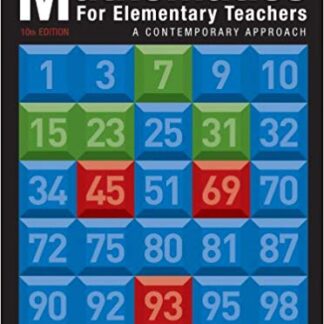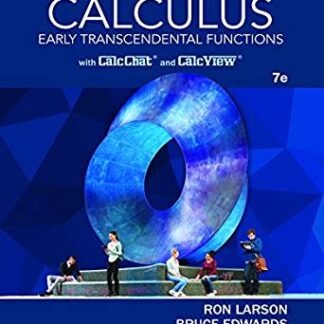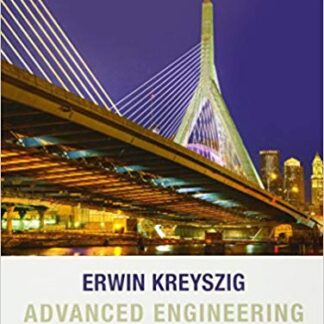Description
Introduction to Statistical Investigations 1st Edition by Nathan Tintle, ISBN-13: 978-1118172148
[PDF eBook eTextbook] – Available Instantly
- Publisher: Wiley; 1st edition (May 9, 2016)
- Language: English
- 704 pages
- ISBN-10: 1118172140
- ISBN-13: 978-1118172148
Introduction to Statistical Investigations leads students to learn about the process of conducting statistical investigations from data collection, to exploring data, to statistical inference, to drawing appropriate conclusions. The text is designed for a one-semester introductory statistics course.
It focuses on genuine research studies, active learning, and effective use of technology. Simulations and randomization tests introduce statistical inference, yielding a strong conceptual foundation that bridges students to theory-based inference approaches. Repetition allows students to see the logic and scope of inference. This implementation follows the GAISE recommendations endorsed by the American Statistical Association.
Table of Contents:
Preliminaries Introduction to Statistical Investigations 1
Section P.1 Introduction to the Six-Step Method 2
Section P.2 Exploring Data 6
Section P.3 Exploring Random Processes 10
Unit 1 Four Pillars of Inference: Strength, Size, Breadth, and Cause 21
Chapter 1 Significance: How Strong is the Evidence? 22
Section 1.1 Introduction to Chance Models 23
Section 1.2 Measuring the Strength of Evidence 35
Section 1.3 Alternative Measure of Strength of Evidence 46
Section 1.4 What Impacts Strength of Evidence? 53
Section 1.5 Inference for a Single Proportion: Theory-Based Approach 63
Chapter 2 Generalization: How Broadly Do the Results Apply? 102
Section 2.1 Sampling from a Finite Population 103
Section 2.2 Inference for a Single Quantitative Variable 120
Section 2.3 Errors and Significance 138
Chapter 3 Estimation: How Large is the Effect? 163
Section 3.1 Statistical Inference: Confidence Intervals 164
Section 3.2 2SD and Theory-Based Confidence Intervals for a Single Proportion 173
Section 3.3 2SD and Theory-Based Confidence Intervals for a Single Mean 181
Section 3.4 Factors that Affect the Width of a Confidence Interval 187
Section 3.5: Cautions When Conducting Inference 194
Chapter 4 Causation: Can We Say What Caused the Effect? 231
Section 4.1 Association and Confounding 232
Section 4.2 Observational Studies versus Experiments 237
Unit 2 Comparing Two Groups 259
Chapter 5 Comparing Two Proportions 260
Section 5.1 Comparing Two Groups: Categorical Response 261
Section 5.2 Comparing Two Proportions: Simulation-Based Approach 267
Section 5.3 Comparing Two Proportions: Theory-Based Approach 283
Chapter 6 Comparing Two Means 323
Section 6.1 Comparing Two Groups: Quantitative Response 324
Section 6.2 Comparing Two Means: Simulation-Based Approach 331
Section 6.3 Comparing Two Means: Theory-Based Approach 346
Chapter 7 Paired Data: One Quantitative Variable 382
Section 7.1 Paired Designs 383
Section 7.2 Analyzing Paired Data: Simulation-Based Approach 388
Section 7.3 Analyzing Paired Data: Theory-Based Approach 399
Unit 3 Analyzing More General Situations 427
Chapter 8 Comparing More Than Two Proportions 429
Section 8.1 Comparing Multiple Proportions: Simulation-Based Approach 430
Section 8.2 Comparing Multiple Proportions: Theory-Based Approach 440
Chapter 9 Comparing More Than Two Means 475
Section 9.1 Comparing Multiple Means: Simulation-Based Approach 476
Section 9.2 Comparing Multiple Means: Theory-Based Approach 485
Chapter 10 Two Quantitative Variables 520
Section 10.1 Two Quantitative Variables: Scatterplots and Correlation 521
Section 10.2 Inference for the Correlation Coefficient: Simulation-Based Approach 529
Section 10.3 Least Squares Regression 538
Section 10.4 Inference for the Regression Slope: Simulation-Based Approach 547
Section 10.5 Inference for the Regression Slope: Theory-Based Approach 552
Appendix A Calculation Details 592
Appendix B Stratified and Cluster Samples 610
Solutions to Selected Exercises 615
Index 668
Nathan Tintle attained his Ph.D. in Statistics in 2005 from Stony Brook University and has been the primary mentor for over 95 undergraduate students in extended summer and/or academic year research projects in statistics, with the bulk of these students conducting research in statistical genetics and biostatistics.
What makes us different?
• Instant Download
• Always Competitive Pricing
• 100% Privacy
• FREE Sample Available
• 24-7 LIVE Customer Support




